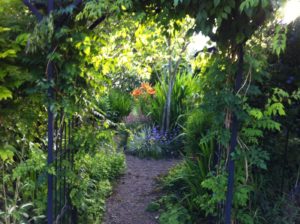 I think that most people that live in a climate with four seasons have experienced this phenomenon. It reminds me of when, after Dorothy took her rough ride over the rainbow, in opening the door of her humble wooden house, she went from a monochromatic view of the world to TECHNICOLOR.
I think that most people that live in a climate with four seasons have experienced this phenomenon. It reminds me of when, after Dorothy took her rough ride over the rainbow, in opening the door of her humble wooden house, she went from a monochromatic view of the world to TECHNICOLOR.
This happened in my neighborhood this past week, The weather is not yet consistently warm, but, it seems that overnight everything became GREEN.
Wow!
A few blossoming trees have opened up too and there’s a decidedly fresher scent in the air. I spotted a handful of brave (or foolish) people on the sidewalks wearing shorts, and I know that restaurant owners are chomping at the bit, ever eager to open their outdoor sections.
Of course, I love the flood of green at this time of year. Just when it’s easy to forgot what it looks like or smells like, or what walking on grass (the epitome of simple, beautiful green) feels like — it overwhelms my senses.
I’ve thought about green a lot this week.
It never went away. But my references for green are decidedly different between November and May than they’ve been this week.
During football season, there’s Philadelphia Eagle or Green Bay Packer green Stores are decorated with pine green during December and shamrock green during March.
Kids play soldier wearing camouflage green. They’ll eat green M&Ms or handle neon green clay or slime all year ‘round.
Shades of green are synonymous with the gem stone they resemble; emerald, jade, and malachite.
Wine and beer bottles are often green. Flags of nations sport different shades of green that unmistakably are associated with that geography or ethnicity. I guess the shade of green of the Toronto public transportation system uses is as well-recognized locally as the paint job of the buses run by the Chicago Transit Authority here on the south shore of Lake Michigan.
This week, I have been thinking about the greens of nature. There is not ONE green. There is an infinite number of shades and depths. The names we use to describe different shades of green often come from objects in nature. Each name makes us think about a unique mixture of light and tone; each a very particular green.
Artichoke
Asparagus
Avacado,
Fern
Forest
Jungle
Mint
Moss
Myrtle
Pistanchio
Reseda
Tea
…and more
That’s part of the beauty. The uniqueness of each shade, the variety, the range of difference between things that might be grouped together. From hunter green to laurel green to chartreuse — they’re all different. And ALL are green.
When I take a moment to look at a patch of grass at my feet, I’ll marvel at the blue or yellow undertones in what is essentially green. From the hostas that grow at the side of my building to the dandelion stems that seem to be everywhere, I can no longer simply say that my world has gone GREEN.
Rather, it is teeming with GREENS
Celebrating the diversity of nature is no small thing.


Leave a comment